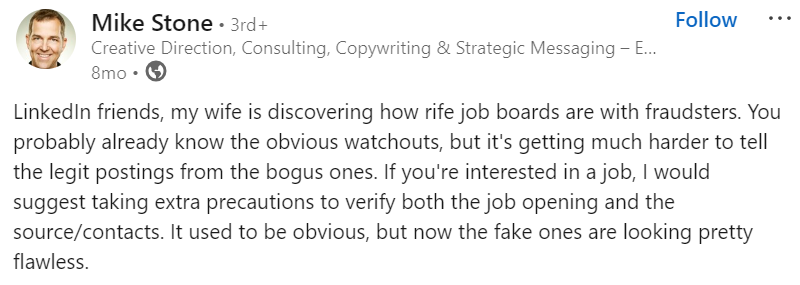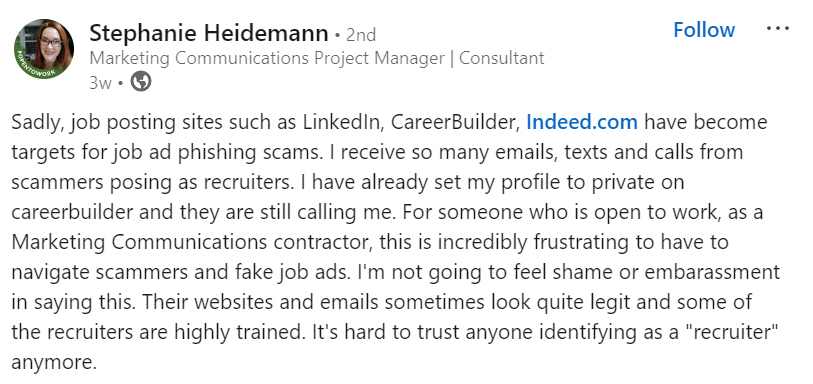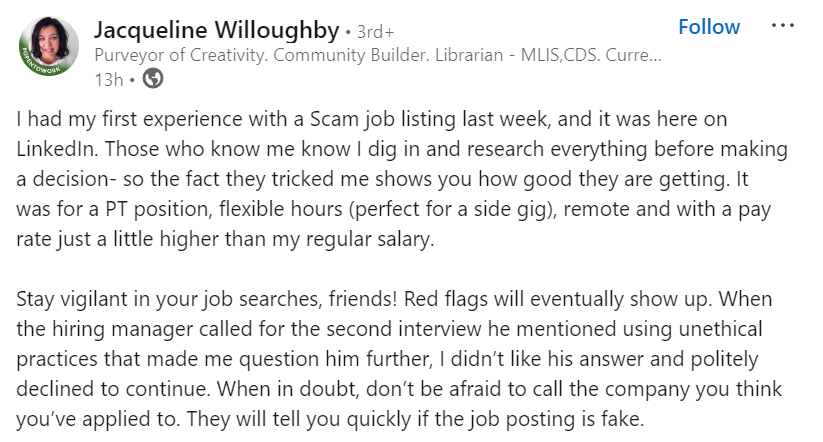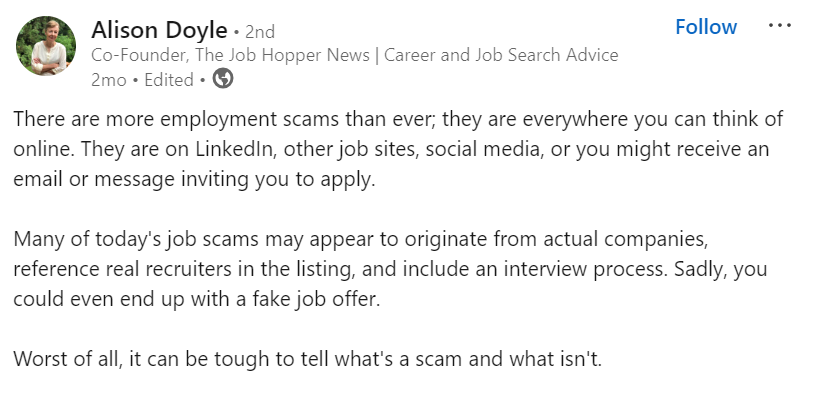LinkedIn job posts can include genuine opportunities and fake listings. Resume Builder surveyed 1,641 hiring managers earlier this year. Of them, 40% indicated they posted a fake job listing within the past year. What’s even more troubling is that their findings state that seven out of ten hiring managers believe it’s morally acceptable to post fake job listings.
So, how can job seekers tell if LinkedIn posts are real? Here’s how to determine their authenticity and effectiveness.

Indicators of Authentic LinkedIn Job Posts
Navigating the job market on LinkedIn can be overwhelming, especially with the increasing prevalence of fraudulent postings. This section highlights key indicators of authentic LinkedIn job posts to help job seekers identify genuine opportunities.
Company Verification
LinkedIn company pages should focus on helping people reach their professional and business goals. Verifying the company’s profile is one of the first steps in assessing the authenticity of a LinkedIn job post.
Official company accounts typically post authentic job listings. LinkedIn has introduced verification features, allowing job posters to authenticate with clear and company email addresses. Job seekers should look for postings from verified company pages to ensure legitimacy. This verification step helps ensure that the job opportunity is credible and from a legitimate source.
LinkedIn Job Posts Should Include Detailed Job Descriptions
A hallmark of genuine job posts is the presence of detailed job descriptions. These descriptions include a comprehensive outline of responsibilities, qualifications, and benefits. Posts that are vague or lack specific details should raise a red flag.
Look for posts with comprehensive job details and avoid those with vague descriptions. A good job post should clearly define responsibilities and qualifications to give candidates an accurate picture of their day-to-day experience. This level of detail helps candidates understand the role and whether they are a good fit for the position.
Contact Information
Authentic job posts often include direct contact information or links to the company’s career page, adding a layer of transparency and legitimacy. Verified job posts now may include a “verified by LinkedIn” tag.
Including contact information adds a layer of transparency and legitimacy to job postings. Having direct contact information allows job seekers to follow up and engage with the company directly, which is another sign of a credible job posting.
Engagement and Interaction
The engagement level on a job post can also indicate its authenticity. Genuine opportunities usually attract meaningful interactions, such as comments and shares from industry professionals. Engagement in job posts, such as comments and shares, can be an indicator of authenticity. High levels of engagement suggest that the job post is being taken seriously by the community and is likely to be legitimate.
💡 Action items:
- Verify the company: Before applying, check if the job post comes from a verified company page on LinkedIn.
- Scrutinize the details: Before applying, ensure the job description is detailed and specific about responsibilities, qualifications, and benefits.
- Look for contact information: Check if the job post includes direct contact details or a link to the company’s career page.
- Observe engagement: Look at the engagement on the post. Genuine posts often have comments and shares from industry professionals.

Indicators of Potential Algorithm Gaming
Navigating LinkedIn for job opportunities can be tricky, especially with some users and companies trying to exploit the platform’s algorithm. This section will help you identify signs of algorithm gaming, ensuring you don’t waste time on posts that aren’t genuinely recruiting. We’ll look at common tactics like excessive hashtag use, frequent posting, and lack of follow-up to help you spot these red flags.
The LinkedIn Job Posts Contain Excessive Use of Hashtags
One common indicator of potential algorithm gaming is the excessive use of hashtags. Posts laden with hashtags such as #hiring or #jobs might be attempting to game the algorithm for increased visibility rather than genuinely seeking candidates.
LinkedIn’s algorithm promotes content engagement, which can be manipulated through excessive hashtag use. Overusing hashtags like #hiring and #jobs may indicate a post is trying to boost visibility rather than attract candidates.
Frequent Posting
Another tactic used to game the algorithm is frequent posting. Users or companies that frequently post about hiring without significant variation might be more interested in maintaining visibility than in genuinely recruiting. LinkedIn Companies that frequently post about hiring without updates may be using posts to stay visible rather than fill positions. This pattern can indicate that the focus is on staying in users’ feeds rather than filling open roles.
Lack of Follow-Up
A lack of follow-up on job posts is another sign of potential algorithm gaming. Genuine recruitment efforts typically include updates on the hiring process or announcements about filled positions. The absence of such follow-up can be a red flag. A lack of follow-up can signal algorithm gaming rather than genuine recruitment efforts.
💡 Action items:
- Beware of hashtag overload: Be cautious of posts with an excessive number of hashtags, which might indicate an attempt to game the algorithm.
- Monitor posting frequency: Observe if the company frequently posts about hiring without substantial updates, indicating a possible algorithm gaming tactic.
- Look for follow-up: Check for follow-up updates on the hiring process or filled positions to ensure the job post is genuine.

Determining the Effectiveness of LinkedIn Job Posts
Understanding how effective LinkedIn job posts are can help both job seekers and recruiters maximize their efforts on the platform. This section will explore various indicators that can help determine the success of job postings on LinkedIn. From company hiring success and employee testimonials to analytics tools and recruitment reports, we’ll provide insights and examples to help you gauge the true impact of LinkedIn job posts.
Company’s Hiring Success
While LinkedIn posts generate 15 times more content impressions than job postings, this high engagement sometimes translates into conversions. Many companies share their hiring success stories and data on LinkedIn, which can help gauge the effectiveness of their job posts.
Employee Testimonials
Employee testimonials from those who found their jobs through LinkedIn can also be a useful indicator. These testimonials are often available on company pages or LinkedIn groups and can provide first-hand accounts of the hiring process.
Sprout Social reports that 40% of B2B marketers find LinkedIn to be the most effective channel for driving high-quality leads. Employee testimonials on LinkedIn often provide insight into the effectiveness of job posts. These stories can give you a better understanding of how effective LinkedIn job posts are in attracting top talent.
Analytics Tools
Companies can utilize LinkedIn’s analytics tools to track the effectiveness of their job posts, although this data isn’t always publicly available. These tools offer valuable insights into a job post’s performance, helping companies refine their strategies.
LinkedIn’s analytics tools offer valuable insights into a job’s post-performance, though this data isn’t always public. While you may not always have access to this information, knowing that these tools exist can reassure you that companies are actively monitoring their job post effectiveness.
Recruitment Reports
Industry reports and surveys on recruitment trends can also provide insights into LinkedIn’s effectiveness as a hiring platform. For example, LinkedIn’s Talent Solutions reports often include data on hiring success rates, offering a broader perspective on recruitment trends. LinkedIn’s annual Talent Solutions report contains data on hiring success rates and is a useful resource for understanding recruitment trends.
💡 Action items:
- Investigate hiring success: Look for companies that share their hiring success stories and data on LinkedIn.
- Look for testimonials: Find and read testimonials from employees who found their jobs through LinkedIn.
- Understand analytics: Be aware that companies use LinkedIn’s analytics tools to track job post’s performance, even if the data isn’t public.
- Review recruitment reports: Look for industry reports and LinkedIn’s Talent Solutions reports to gain insights into the platform’s effectiveness in hiring.

LinkedIn Job Posts: Suggestions for Accurate Assessment
Gathering a range of data and perspectives is important to assess the effectiveness of LinkedIn job posts accurately. This section provides practical suggestions for evaluating LinkedIn job posts through surveys, industry research, and direct engagement with recruiters. These methods will help you gain a clearer understanding of how well LinkedIn serves as a recruitment platform.
Surveys and Polls
One effective method for assessing LinkedIn job posts is to conduct surveys or polls among LinkedIn users. Gathering data on how many people have found jobs through LinkedIn can provide valuable insights into the platform’s effectiveness. Polls can help understand user experiences and job search success rates. LinkedIn Surveys and polls can offer direct feedback from job seekers on the efficacy of LinkedIn job posts. This feedback can help identify trends and areas for improvement.
Industry Research
Another valuable approach is to refer to research studies or industry reports that analyze the effectiveness of social media platforms in recruitment. For example, Kinsta® reports that LinkedIn drives 46% of social traffic to B2B sites, indicating its significant influence in the professional realm.
Research studies provide comprehensive insights into the role of social media platforms like LinkedIn in the recruitment process. These studies offer a broader perspective on how LinkedIn compares to other platforms and its overall impact on recruitment.
Engage with Recruiters
Interacting with recruiters and hiring managers on LinkedIn can provide firsthand insights into their hiring processes. These professionals can reveal how they use LinkedIn job posts and what strategies they find most effective. These interactions can offer practical advice and real-world examples of successful recruitment through LinkedIn.
💡 Action items:
- Conduct surveys: Use LinkedIn’s poll feature to gather data on user experiences and job search success rates.
- Refer to research: Look up industry reports and research studies on the effectiveness of LinkedIn in recruitment.
- Engage with professionals: Connect with and ask recruiters about their experiences and strategies with LinkedIn job posts.
Maximizing LinkedIn Job Posts Search Success
Using these strategies, you can better gauge the authenticity and effectiveness of LinkedIn job posts and find real opportunities.
